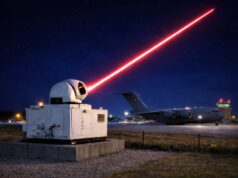In their joint statement, the US Navy’s acquisition chief and the US Air Force general who runs the program said “our overall assessment is that the F-35 is making solid progress across the board”.
“F-35 is executing well across the entire spectrum of acquisition, to include development and design, flight test, production, fielding and base stand-up, sustainment of fielded aircraft, and building of a global sustainment enterprise.”
This comes as a new spending report also shows steady cost drop for all variants of the F-35.
Earlier in March, the annual Selected Acquisition Reports (SAR) for 2015 was released. This report provides status on programme cost, schedule, and performance as of December 2015.
It has been revealed that the Pentagon’s estimate for the total acquisition cost of the F-35 program is $379 billion, down from $391 billion projected in 2014.
According to a statement from the F-35’s project office:
“The overall Acquisition Cost (RDT&E, Procurement, and MILCON) of the program decreased by $7B in base year 2012 dollars (BY12$) and $12.1B in then-year dollars (TY$). The increase of $16B (BY12) and $95.2 (TY$) to Total Program Cost is the net impact resulting from a transfer of $300M to RDT&E, a $7.5B decrease in Procurement, an approximately $200M increase in MILCON, and a $23B increase in O&S.
The RDT&E increase is the result of a transfer of money from the Procurement account to the RDT&E account to fund the modification of 24 Operational Test aircraft for Initial Operational Test and Evaluation, in accordance with Service guidance.
This transfer out of Procurement into RDT&E had zero net effect on Total Program Cost.”
According to F-35 Joint Program Office chief Lt. Gen Christopher Bogdan:
“We are coming down the learning curve and the price curve a little steeper. We are coming down the price curve faster than we anticipated years ago.”
The average unit cost of the aircraft decreased by:
$1.8M for the F-35A
$0.7M for the F-35B
$1.0M for the F-35C
Jeff Babione, Lockheed Martin’s programme manager for the F-35, told reporters that the cost of the F-35A will drop to about $85 million by 2019. This is understood to be thanks to efficiencies and cost-cutting manufacturing technologies. The B and C variants are also steadily reducing in cost.
By contrast, the US Navy’s F/A-18 Super Hornet aircraft cost about $60 million apiece.
Looking back at last years SAR, the average cost-per-unit for the aircraft for low-rate initial production lots six, seven and eight had also fallen as shown below, the figures also include engines and adjust for inflation and show the continued drop in price.
F-35A conventional takeoff and landing model: $117 million, $112 million, $108 million
F-35B “jump-jet” model: $145 million, $137 million, $134 million
F-35C carrier variant: $134 million, $130 million, $129 million
Back to the current SAR, the estimate of annual operating cost decreased by an average of two percent and the estimated steady state cost per flying hour decreased by:
2.2 percent for the F-35A,
3.3 percent for the F-35B,
4.2 percent for the F-35C
These reductions were reportedly the result of improved maintainability and sustainability as the aircraft matures, the design stabilises, and maintenance of the aircraft becomes more efficient and effective.
F-35 unit costs have been going down with each successive lot of aircraft and will continue to. The bottom line is that overall programme costs have gone down and continue to massively decrease annually.













Generic Harrier comment